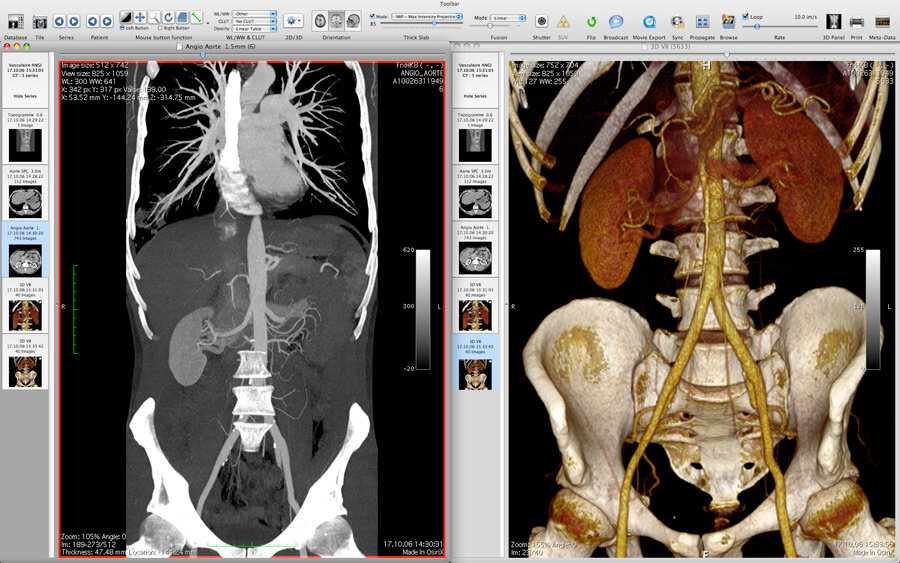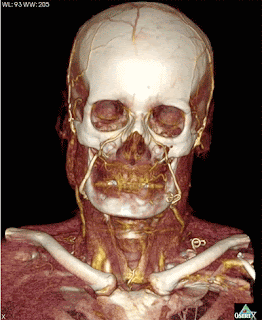Osirix
 Let's talk about what's happening in the world of medical imaging, since it's having such an impact on medical illustration.If you haven't already heard of the groundbreaking image processing software, OsiriX, then please take a look the website and familiarize yourself. I suggest you jump immediately to the screenshots, just to give an overview of what OsiriX can offer. You can also find more fabulous movies, like the one above, there.OsiriX is DICOM image-viewing software. DICOM (Digital Imaging and Communications in Medicine) is a comprehensive set of standards for handling, storing and transmitting information in medical imaging. These medical images can come from medical imaging modalities such as MRI, CT, PET scans, etc.
Let's talk about what's happening in the world of medical imaging, since it's having such an impact on medical illustration.If you haven't already heard of the groundbreaking image processing software, OsiriX, then please take a look the website and familiarize yourself. I suggest you jump immediately to the screenshots, just to give an overview of what OsiriX can offer. You can also find more fabulous movies, like the one above, there.OsiriX is DICOM image-viewing software. DICOM (Digital Imaging and Communications in Medicine) is a comprehensive set of standards for handling, storing and transmitting information in medical imaging. These medical images can come from medical imaging modalities such as MRI, CT, PET scans, etc. What makes OsiriX so incredible is that it is changing the way medical professionals view and share medical images. It is also seamlessly tied into the Mac OS X platform. Images can easily be shared using iChat AV, can be easily stored to iDisk, and can become mobile using iPods.iPods are no longer simply used for music. With an iPod you're carrying around 20 to 40 GB of space, something comparable to the disk on a laptop. Think about the value of transporting medical images! Radiologists are already using iPods to view and share images.So why is this type of software so important to medical illustrators?While it may seem that the incredible 3D medical images produced with the OsiriX software could put an end to medical illustration, just remember one thing—medical images are still raw images. Like photos, they can contain too much information. Our goal as medical illustrators is to extract the important details and leave out the extraneous. The medical professionals using OsiriX, such as physicians and radiologists, are using the images for diagnostic purposes. Medical illustrators can use these highly detailed images for educational purposes. Most importantly, we can use them to create the most accurate illustrations possible. In the past, the only access to seeing anatomy was through dissection of human cadavers, through low resolution x-rays, and slices from MRI and CT scans. Now we can get 3D and even 4D renderings of these medical images through programs like OsiriX that can compile the data and reconstruct it in a useful, highly visual way.It will be students in the near future that will get the most benefits from programs like OsiriX. They'll be the ones who will get the most accurate representations of the human body yet. And it's up to medical illustrators to make sure that the medical images used by medical professionals be translated into educational material.To learn more about OsiriX, visit these links:OsiriX HomepageiPod Helps Radiologists Manage Medical ImagesiPod ImagingOsiriX Combines Open Source with Key Apple Technologies
What makes OsiriX so incredible is that it is changing the way medical professionals view and share medical images. It is also seamlessly tied into the Mac OS X platform. Images can easily be shared using iChat AV, can be easily stored to iDisk, and can become mobile using iPods.iPods are no longer simply used for music. With an iPod you're carrying around 20 to 40 GB of space, something comparable to the disk on a laptop. Think about the value of transporting medical images! Radiologists are already using iPods to view and share images.So why is this type of software so important to medical illustrators?While it may seem that the incredible 3D medical images produced with the OsiriX software could put an end to medical illustration, just remember one thing—medical images are still raw images. Like photos, they can contain too much information. Our goal as medical illustrators is to extract the important details and leave out the extraneous. The medical professionals using OsiriX, such as physicians and radiologists, are using the images for diagnostic purposes. Medical illustrators can use these highly detailed images for educational purposes. Most importantly, we can use them to create the most accurate illustrations possible. In the past, the only access to seeing anatomy was through dissection of human cadavers, through low resolution x-rays, and slices from MRI and CT scans. Now we can get 3D and even 4D renderings of these medical images through programs like OsiriX that can compile the data and reconstruct it in a useful, highly visual way.It will be students in the near future that will get the most benefits from programs like OsiriX. They'll be the ones who will get the most accurate representations of the human body yet. And it's up to medical illustrators to make sure that the medical images used by medical professionals be translated into educational material.To learn more about OsiriX, visit these links:OsiriX HomepageiPod Helps Radiologists Manage Medical ImagesiPod ImagingOsiriX Combines Open Source with Key Apple Technologies
